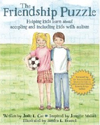by Beth Finke
Remember our blog post last March about the Extreme Home Makeover show? Back then, actress Marlee Matlin had appeared on Extreme Makeover: Home Edition to present a $50,000 college scholarship to Stefan Vardon. Stefan’s parents are both deaf and his younger brother has autism. Matlin is an amazing advocate for people with disabilities and is an Easter Seals Honorary Board Member.
And then, just two months ago, another member of our Easter Seals family was featured on an Extreme Makeover: Home Edition episode. Eight-year-old Jake Grys has brittle bone disease and receives services at Easter Seals Peoria-Bloomington. One of Jake’s therapists at Easter Seals is Angie DeLost. Angie nominated the Grys family, and on January 11 they were featured on the popular ABC show.
And now a third member of the Easter Seals family will be featured on Extreme Makeover: Home Edition. This Sunday, Easter Seals 2005 National Adult Representative MaryAnn Riojas and her family will tell their remarkable story and tour their new beautiful and accessible home in Fresno, California. Easter Seals first approached the popular program about building a home for MaryAnn and her family a few years ago and our persistence paid off!
Born without legs and only one fully developed arm, MaryAnn spent her childhood in foster care, moving from one family to the next. When MaryAnn was 5, Easter Seals provided her with her first wheel chair. Shortly after, she enrolled in swimming lessons through Easter Seals and attended Easter Seals camp. As an adult, MaryAnn worked for Easter Seals Central California’s Child Development Center. In her role as Easter Seals National Adult Representative, MaryAnn and her family traveled the country, sharing their story with our many volunteers, donors, corporate partners, staff and other families.
CVS Caremark, a national advertiser of the show, engaged their associates in helping to renovate the Riojas home and took the opportunity to make a $25,000 commitment to Easter Seals Central California in MaryAnn’s name. Funds will be used to support Easter Seals’ Fresno-based Child Development Center and introduce a lily garden at the Center. This is the second time that CVS used their support of the show to benefit Easter Seals. Last year, when the Vardon family in Alabama received a Home makeover, CVS committed $25,000 to Easter Seals to introduce a literacy center in the family’s name.
Extreme Home Makeover improves the lives of deserving families across the country through the generosity of thousands of volunteers. All materials and labor are donated for every house that is built. Easter Seals has long known the power of its volunteers, and watching this show reinforces in a meaningful way the lesson that Easter Seals volunteers have demonstrated for years — together, we can accomplish great things.







